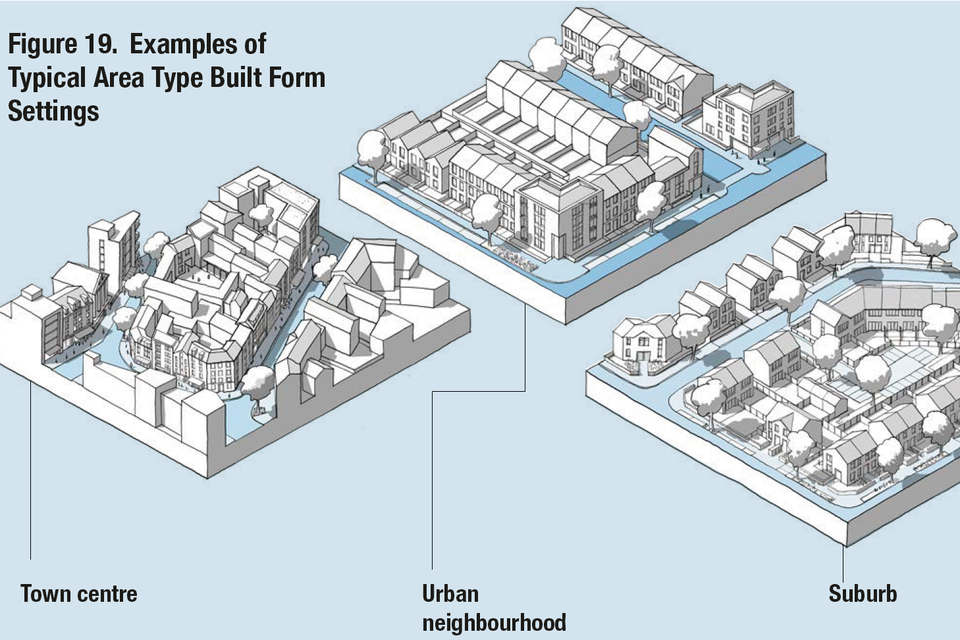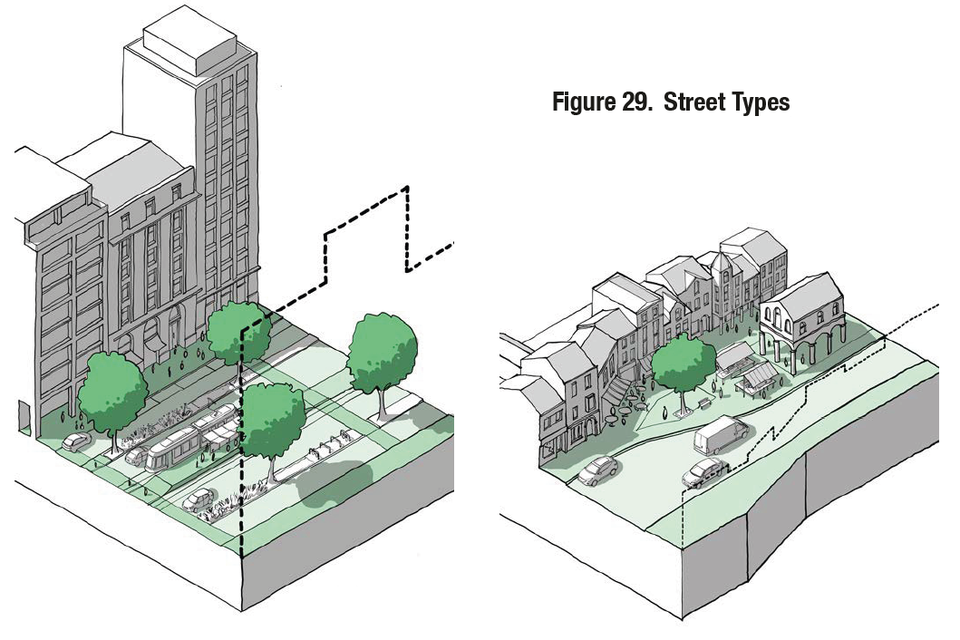All new developments must meet local standards of beauty, quality and design under new rules
Local communities will be at the heart of plans to make sure that new developments in their area are beautiful and well-designed, under proposals outlined by Housing Secretary Rt Hon Robert Jenrick MP today (30 January 2021).
In response to the Building Better, Building Beautiful Commission report, the government is today:
- Proposing changes to the National Planning Policy Framework to place greater emphasis on beauty and place-making, and to ensure that all new streets are lined with trees.
- Publishing a draft national design code that provides a checklist of design principles to consider for new developments, such as street character, building type, façade, and the requirements that address wellbeing and environmental impact, which councils can use as a foundation for their own local design codes.
- Encouraging all councils to publish their unique design code, so residents have a real say in the design of new developments in their area.
- Creating an ‘Office for Place’ within the next year, which will support local communities to turn their designs into the standard for all new buildings in their area.
- Opening a new Community Housing Fund to support community-based organisations to bring forward local housebuilding projects for the £11.5 billion Affordable Homes Programme, backed by £4 million of support for local plan.
- And doubling the available funding for areas under the “local heritage listing – monuments men” campaign, with up to £1.5 million now available for communities to nominate local heritage sites including historical buildings or modern architecture, art and memorials for inclusion in their council’s local heritage list.
Taken together, these measures will help the country to Build Back Better and ensure that current and new residents alike will benefit from beautiful homes in well-designed neighbourhoods as we recover from this pandemic.
Greater concentration will now be placed on the quality, design and the environment in planning than ever before, with the local community fully involved in how they want new developments to look and feel. For example, the proposed changes to the National Planning Policy Framework will set an expectation that good quality design will be approved while poor quality will be rejected, and includes a commitment to ensure that all streets are lined with trees.
The measures mean the word “beauty” will be specifically included in planning rules for the first time since the system was created in 1947 – going back to a previous time when there was a greater emphasis on whether a building was considered attractive to local people.

Housing Secretary Rt Hon Robert Jenrick MP said:
We should aspire to pass on our heritage to our successors, not depleted but enhanced. In order to do that, we need to bring about a profound and lasting change in the buildings that we build, which is one of the reasons we are placing a greater emphasis on locally popular design, quality and access to nature, through our national planning policies and introducing the National Model Design Codes.
These will enable local people to set the rules for what developments in their area should look like, ensuring that they reflect and enhance their surroundings and preserve our local character and identity.
Instead of developers forcing plans on locals, they will need to adapt to proposals from local people, ensuring that current and new residents alike will benefit from beautiful homes in well-designed neighbourhoods.
The government has published a new National Model Design Code that outlines the design standards new developments are expected to meet. This provides a checklist that will guide local councils to create their own, unique, local design code, centred on genuine community involvement so residents have a real say in the design of new developments, embracing the history, culture and heritage of their local area.
It is the government’s ambition that every council will produce a local design code and guide, to set expectations for beauty and well-designed homes and places in their local area and to give a simple process to local communities so they can have their say.
Nicholas Boys Smith, Chair of the Design Body Steering Group, said:
There is no fundamental reason that prevents the creation of streets and squares, homes as places where we can lead happy, healthy, and connected lives. In these places we can know more of our neighbours and be more joyful as we go about our daily lives. As a society we have not done this, and we are paying the consequences.
I am delighted that the government is implementing so many of the Building Better Building Beautiful Commission’s findings and would like to thank them for their work to undertake this. I am honoured to be asked to chair the transition board of the Interim Office for Place and look forward to our work to help deliver new places and manage existing places to be beautiful, popular, healthy and sustainable.
Our ultimate purpose will be to make it easier for neighbourhood communities to ask for what they find beautiful and to refuse what they find ugly.
Victoria Hills, chief executive of the Royal Town Planning Institute said:
As a member of the government’s Design Body Steering Group, I welcome MHCLG’s commitment to good quality design. The RTPI has long called for design to be an integral part of the planning process. A survey in 2020 revealed that 88% of our members wanted greater powers to reject poor design and lacked the capacity and resources to do so.
I am therefore delighted that the government has listened and pledged to not only strengthen the National Planning Policy Framework to empower local planning authorities to prioritise design and drive up quality, but has also committed to inject much-needed funding in this area.
I am also pleased that communities will be at the heart of this process. It has never been more important, in the wake of the pandemic, that communities have a say on how their local area looks. Planners and the planning system must play an active role in driving up design quality in all areas of England and we look forward to making an ongoing contribution to this work in advance of the forthcoming Planning Bill.

The government is also putting support in place for councils and communities to help them set expectations of design quality in their area. This includes the creation of an ‘Office for Place’ within the next year which will pioneer design and beauty within the planning system. The new organisation will draw on Britain’s world-class design expertise to support communities to turn their visions of beautiful design into local standards that all new buildings will be required to meet.
An interim Office for Place will be established in the department immediately with a transition board chaired by Nicholas Boys Smith, tasked with considering what form the organisation should take, informed by responses to the planning reform consultation.
This team will this year be piloting the National Model Design Code with 20 communities and empowering local authorities to demand beauty, design quality and place-making, through training on the principles outlined in the National Model Design Code.
Expressions of interest are now open for the first 10 councils to sign up, with these to receive a share of an initial £500,000. The proposals are now out for consultation for a period of 8 weeks.
The government is also relaunching the Community Housing Fund, making £4 million available to help Community Land Trusts (CLTs) bid for funds to support them to prepare bids for the £11.5 billion Affordable Homes Programme. This programme is the largest investment in affordable housing in a decade and will provide up to 180,000 new homes across the country, should economic conditions allow.
This will help to diversify the homebuilding sector, improving design, sustainability and build quality by developing modern methods of construction.
The government is also encouraging communities to nominate historic buildings and other heritage assets such as memorials and plaques for their council’s local heritage list – helping to protect the historic buildings and heritage truly valued in their area.
Following an overwhelmingly positive response to the expressions of interest launched in October 2020, funding has been doubled – to £1.5 million – allowing 22 areas to now be involved in the pilot, instead of the 10 originally announced.
This follows the appointment of Charles O’Brien as the government’s Listing Heritage Adviser to help conserve some of England’s historic buildings as part of the most ambitious local heritage campaign for 40 years. This is the first time such a post has been created since the 1980s and has echoes of the famous Monuments Men who battled to save historic buildings and artefacts from bulldozers during the Second World War.
Together, these new proposals will make sure that local residents are at the heart of new developments in their community, with beauty, wellbeing and a communal spirit at its centre as we Build Back Better.

